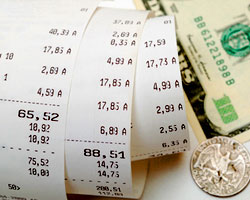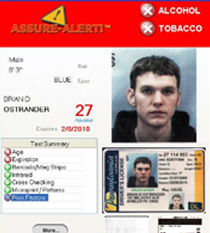 According to a recent survey of major U.S. retailers, conducted by the National Retail Federation, retail return fraud is estimated to be about $2.9 Billion this Christmas shopping season. That's Billion with a capital "B".
According to a recent survey of major U.S. retailers, conducted by the National Retail Federation, retail return fraud is estimated to be about $2.9 Billion this Christmas shopping season. That's Billion with a capital "B".
Overall, retailers anticipate up to 4.6% of all returns will be fraudulent. Most retail return fraud is committed using fake receipts or original receipts to return stolen items as well as returning worn or used items. Annually, return fraud is estimated at nearly $9 Billion.
Retail return fraud is so prevalent that some retailers (about 7%) have adopted policies requiring customers returning any merchandise to present a valid ID. Nearly three quarters of retailers polled require some form of identification for returns not accompanied by a receipt. However, slightly more than three quarters of retailers do not require any identification at all when returning merchandise to the store.
In addition, nearly 20% of retailers have dealt with e-receipt fraud. Over 80% of retailers allow on line purchases to be returned in store and it is estimated that approximately 4% of these returns are fraudulent.
In spite of these numbers over 80% of retailers will not change their return policies this year. Incredibly, about 10 of the retailers polled will actually loosen their policies to make it easier for legitimate customers to make merchandise returns.
So what can your business do to reduce or prevent retail return fraud?
We believe that validation of ID documents at the return counter during your return transactions will immediately decrease the number of fraudulent returns experienced in your stores. The concept is simple. If an ID is discovered to be a fake, the return would simply be denied. All it would take is the installation of a machine that validates ID documents and a change in your return policy to require the employees working the returns counter to validate ID's with every return.
In reality, what will likely happen is that the fraudulent returns will simply stop coming to your stores. In very short order, fraudsters will realize that your stores are secured, and that attempting to conduct fraudulent returns in your locations is not likely to succeed. Many of our customers have reported that the simple act of conducting a test of validity during a transaction has the effect of deterring would-be criminals from attempting to pass such fraudulent documents.
How to validate ID documents?
FraudFighter proposes two possible solutions to the ID validation issue.
The first of these is to use our award-winning line of UV Counterfeit Detectors, together with our recently updated UV DL GuideBook. This low-cost solution enables store level employees to confirm that driver license documents presented as identification do, in fact, contain the ultra-violet security features designed into them by the different states. This is not an absolutely sure-fire way to authenticate licenses, since some of the best counterfeit ID's do have imperfect replicas of the UV security features, but, as stated above, our experience has shown that conducting a validation examination of any kind can have a serious impact on the volume of fraudulent transactions.
of UV Counterfeit Detectors, together with our recently updated UV DL GuideBook. This low-cost solution enables store level employees to confirm that driver license documents presented as identification do, in fact, contain the ultra-violet security features designed into them by the different states. This is not an absolutely sure-fire way to authenticate licenses, since some of the best counterfeit ID's do have imperfect replicas of the UV security features, but, as stated above, our experience has shown that conducting a validation examination of any kind can have a serious impact on the volume of fraudulent transactions.
 The second option would be to use identification data capture and authentication equipment ("ICA") at your point of sale. These ICA devices are designed to authenticate ID documents, by conducting high-confidence pattern matching and data-matching inspection of the document. In addition, they will capture customer information into an encrypted database and maintain the information, including images of the picture on the license, in the event that an investigation needs to be conducted.
The second option would be to use identification data capture and authentication equipment ("ICA") at your point of sale. These ICA devices are designed to authenticate ID documents, by conducting high-confidence pattern matching and data-matching inspection of the document. In addition, they will capture customer information into an encrypted database and maintain the information, including images of the picture on the license, in the event that an investigation needs to be conducted.
Also, by capturing ID data you can build a database of known "return offenders" so that when one of these people show up in your store, not only will you deny the return but you can present law enforcement with hard evidence that this person is a retail return fraud offender. The hard evidence in question is a high resolution image of the persons identification regardless of whether it is real or fake.
Do what you can to strike a comfortable balance between convenience for legitimate customers seeking to return a product and those people seeking to defraud your business. Requiring an ID and testing it - either with UV detectors, or with an identification data capture and authentication scanner - is a nonintrusive way to strike that balance and protect your business from fraud.



